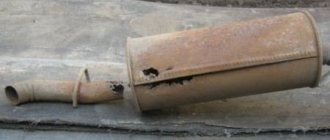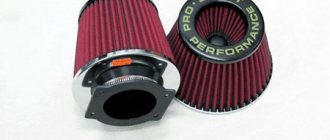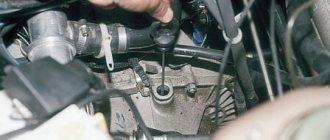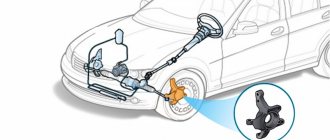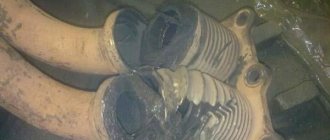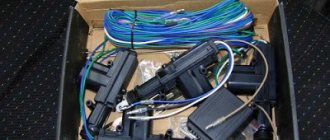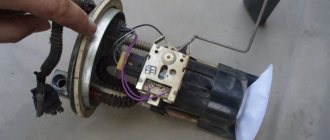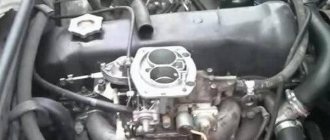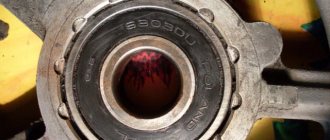Anyone who has ever thought about tuning a car knows for sure that one of the parts of tuning an “iron horse” is tuning the exhaust system. Direct-flow mufflers and flame arresters are installed to replace the removed catastrophes. In our article today we will talk about the latter.
The catalyst (cat) , as we used to call it, is correctly called a catalytic converter-neutralizer. It is a part of the vehicle exhaust system, which ensures the neutralization of harmful fuel combustion products by reducing nitrogen oxides and using the resulting oxygen to oxidize carbon monoxide and unburned carbons. Let's remember the school chemistry course, which states that a catalyst is a substance that promotes the accelerated occurrence of a reaction, but does not itself participate in this reaction.
Such substances include rhodium, platinum, copper and some others. Automobile cat uses the ability of these substances to accelerate chemical reactions. With proper operation of the car: timely maintenance, use of high quality fuel, integrity of the mechanical parts of the engine, a working fuel supply system - the cat can operate for about 300,000 km. However, if it fails, then replacing it costs quite a lot of money, since it uses expensive materials.
There has long been a prejudice among people that kat extinguishes engine power. But this is an absolute LIE!!! A unit that does not have breakdowns does not interfere with the normal movement of exhaust gases. Possible reasons for the loss of khat permeability are melting and clogging of the honeycombs inside the khat, which are the result of careless car care and operation with problems in the ignition and fuel supply systems. And as an exception, and with low quality fuel.
When cutting out the catalyst (whether new or old) there will be no increase in engine power. This is all people's speculation. However, your car will start to roar much louder. And the sound of the car will become more like a sports car, and it will seem to you that the car has received an increase in power. It sounds louder - it means it's rushing!
Catalyst heating: features
In some cases, the catalyst becomes very hot, turns red and begins to glow. This is due to incompletely burned fuel entering the catalytic analyzer. It begins to burn right in the device. The reason for this may be the following phenomena.
- The mixture does not ignite in the cylinder.
- The membrane maintaining fuel pressure has burst.
- The injectors are filled with a combustible mixture.
Due to the strong heating of the catalyst, the car loses its power, you can hear the engine starting to stall, and thick acrid smoke comes out of the engine compartment. To repair a car, you need the help of car service specialists. How to replace the catalyst?
The part is attached to the resonator through a flange connection with two bolts. The downpipe holds the catalyst with a spring-loaded flange and two flares. A metal-asbestos ring is installed between them. Thanks to this connection, vibration does not transfer from the engine to the exhaust system.
During replacement, it is not necessary to look for new bolts and new springs. They only need to be replaced if they were damaged during disassembly.
A new ring must be installed. Penetrating gases can penetrate through the old one, which will damage the flaring of the catalyst. After installing the new catalyst, lightly screw in the mounting bolts. Full tightening begins with the bracket securing the resonator.
How to repair the exhaust system
Repair of exhaust system parts is done only if holes from mechanical impact have been discovered. If the pipe breaks and the tank burns out, it is necessary to completely replace the parts. Their warranty period has expired. It must be said that metal expansion joints are changed in any case, regardless of the condition of the exhaust system.
Due to the fact that the catalyst is very expensive, amateurs weld a stronger instead. The catalyst is cut off, leaving only the connecting flanges together with the flaring. A stronger is welded into the vacant space. This part costs much less than the catalyst. However, the stronger is not able to burn the remaining gasoline. For this reason, it can only be mounted on a car equipped with a lambda probe. After installing the stronger, gasoline consumption increases by approximately 10%.
Cars equipped with engines with 16 valves often have two metal expansion joints attached to the “pants”. The size of such corrugation does not exceed 50 mm. The cost of such a receiving pipe is incredibly high. The industry does not produce metal expansion joints of this size. The only solution is to insert a corrugation measuring 100 mm and then adjust the length. Welding is done end-to-end with the “pants” and the gasket flange.
Part Description
Experts from their practical experience have concluded that replacing the catalyst on a VAZ 2110 should be carried out after every 100,000 km. This is due to the fact that the catalyst belongs to the group of filter parts. Over time, it becomes clogged and its properties no longer correspond to the factory ones. The catalyst for a car is made of ceramics and metal.
Internal parts contain platinum, which is why prices for catalytic analyzers are quite high. Today, the catalyst is installed on all Lada cars. The exhaust system of a car does not require periodic repairs or frequent replacement. Typically, replacement of components of such a system occurs in several cases:
- parts burned out;
- loud noise is heard;
- The connecting pipe has come off.
The VAZ 2110 has an exhaust system consisting of separate parts:
- muffler;
- resonator;
- catalyst;
- intake pipe.
Sometimes a car is produced without a catalyst, or it is attached to the exhaust manifold.
Return to contents
Independent production and installation of a flame arrester
Most auto-tuning workshops have found an alternative version of the catalyst. A flame arrester is installed instead. It can be easily made even in the garage. Auto mechanic services are not required. The main function of a flame arrester is to extinguish the fire escaping from the collector.
This flame has a very high temperature, so one of the muffler parts may burn out. If you weld an ordinary straight pipe instead of a catalyst, removing the internal parts located in the body of the catalyst, the exhaust system will quickly become unusable.
It will simply burst and burn out, and you will have to completely replace it. A flame arrester comes to the rescue, which has properties similar to those of the catalyst. It does not interfere with the movement of flows and is much cheaper than a catalyst. You can buy such a flame arrester at auto parts stores. But sometimes they are not on sale. Therefore, the part is often made by hand. To work you must have:
- metal pipes;
- steel brushes;
- welding machine.
Pipes must have specific diameters. One should match the size of the exhaust system, the other should be slightly larger. Six-millimeter holes are made in the first pipe with a diameter corresponding to the diameter of the leading system pipe. They are drilled along the entire circumference and length. It is then inserted into a pipe with a larger diameter and, after centering, welded at one end.
Using brushes, the pipes are stretched and then pushed inside. They are compacted with a steel rod. This operation is done until the entire free space of a larger diameter pipe is filled with brushes. When the operation using brushes is completed, the free end of the pipe is welded, the edges are first bent.
The result was a ready-made flame arrester, made independently. This part can be mounted on a car instead of a catalyst. A vehicle equipped with a flame arrester will run perfectly and quietly.
What is a flame arrester?
A flame arrester is a type of resonator, its job is to receive and process exhaust gases from the engine, cool and slow them down. The flame arrester is installed immediately after the exhaust pipe of the muffler, in the same place where the catalyst (catalytic converter) is usually located. This element of the vehicle exhaust system operates under extremely harsh conditions, which determines the features of its design.
A flame arrester is a small-diameter perforated pipe, which is enclosed in a durable (steel) casing. Between the perforated pipe and the housing there is a heat-resistant material that absorbs sound waves and vibration. The ends of the flame arrester are welded, the device has an inlet and an outlet, this must be taken into account in order to install it correctly. As a rule, various types of mineral wool are used as absorbent material. The design of a flame arrester with diffusers (funnels) instead of conventional perforations is considered more advanced; with their help, the temperature of the gas stream is reduced more effectively. Sometimes the device may not be installed on the intake pipe or main line, but directly in the exhaust manifold block. This is a manifold flame arrester.
Flame arrestor circuit
Strongers and flame arresters, what are they?
The etiology of the name of this part is not entirely clear. Why exactly “flame arrester”? In English, a flash suppressor is commonly referred to as a "resonator", "front or pre-silencer".
The temperature of the exhaust flowing from the combustion chamber of the engine is extremely high, in addition, the gases move at high speed. The flame arrester must accept them, cool them, reduce the speed, and also mix the flows emanating from different cylinders. In addition to internal loads, this unit is also affected by external loads, and they are also very serious: constant vibration from a running engine, as well as a hellish saline solution that constantly floods the hot flame arrester in winter.
Therefore, the material from which the flame arrester is made must withstand high temperatures (and temperature changes), as well as exposure to an aggressive environment. Typically, heat-resistant stainless steel is used for this car part.
There are several types of flame arresters:
- Active. This is a single-layer device and uses synthetic fibers or mineral wool to reduce vibration. The disadvantage of such flame arresters is their short durability - the filler simply burns out from high temperatures. However, while they work, such flame arresters do their job well.
- Reactive. Their work is based on the reflection of sound waves. Such products are good for their durability.
Replacing the catalyst on a VAZ 2110
When should you change the catalyst? 1) If the catalyst is severely clogged, which is accompanied by: • Loss of vehicle power. • Also, if the catalyst is clogged, the tachometer needle may simply float at idle.
2) After the catalyst becomes clogged, over time it begins to collapse, and therefore various sounds will appear inside the catalyst itself, such as: • Rumble. • Or just its humming.
What can cause a catalytic converter to fail? 1) The main reason is low-quality fuel, especially if your car has a catalyst installed, then you are strictly prohibited from using leaded gasoline for the engine, as its use can lead to destruction of the catalyst.
2) The catalyst may also fail if a malfunction occurs in the ignition system.
Self-replacement
Replacing the exhaust manifold of a VAZ 2110
- the car needs to be driven into the garage;
- hang a lamp with a safety light under the hood;
- before starting repairs, antifreeze must be drained from the tank;
- disconnect the battery terminals;
- take it out;
- put on a rack;
- disconnect the vacuum booster hose from the receiver;
- also disconnect the hoses of the electric pneumatic valve cover and the ramp pressure regulator;
- disconnect the chips of the throttle sensor, idle air control;
- disconnect the throttle valve cable;
- loosen the clamp on the air supply hose to the air flow sensor housing;
- disconnect it;
- loosen the clamps for attaching the hoses to the throttle pipe and ventilation of crankcase gases on the cylinder head cover;
Replacing the cathode collector for a VAZ 2110
- remove the hoses in pairs;
- loosen the crankcase ventilation hose clamp;
- remove it from the throttle assembly;
- In the same way, carry out further work with the coolant inlet and outlet hoses.
Note. Use a 13mm socket to make the work easier, unscrew the 2 nuts from the throttle assembly from the studs. The throttle assembly is attached to the receiver.
- loosen the clamp;
- disconnect the adsorber purge hose;
- remove the throttle assembly;
- remove the sealing gasket.
Note: these nuts must be unscrewed using a number 13 wrench.
The receiver must be removed together with the throttle assembly. In addition, it is necessary to disconnect all inlet and outlet hoses and idle speed sensor chips from the assembly. Carefully check to make sure that all fastenings are completely loosened.
Note: it is recommended to remember all the attachment points; you can use threads of different colors. To prevent incorrect connections during assembly.
Note: place the parts in a container so that during assembly you do not have to look for missing spare parts.
Unscrew the 2 nuts for attaching the fuel supply and outlet pipe bracket to the receiver. The same - 1 nut for fastening the receiver to the bracket, 5 pieces for fastening to the intake manifold. Remove the receiver, remove the gasket.
Removing the catalyst: pros and cons: what the consequences may be
How to replace the catalyst on a VAZ 2110-VAZ 2112?
Removal: 1) First, unscrew the two nuts of the bolts that secure the catalyst to the resonator, holding the bolt from turning with one spanner, and with the other at the same time, unscrew the nut securing this bolt.
2) Next, move to the two bolts that secure the catalyst to the exhaust pipe of the car, and then completely unscrew them.
Note! When you unscrew the last bolt, hold the catalyst itself with your hand to prevent it from falling!
3) And to complete the operation, remove both bolts, along with two springs.
Note! Be sure to replace all cracked or deformed springs with new ones!
Installation: 1) First, install two springs on the bolts that secure the catalyst to the exhaust pipe of the car.
2) Next, attach the edge of the new catalyst to the exhaust pipe of the car, and then tighten the two retaining bolts with springs.
3) And to complete the operation, using two spanners, tighten the two nuts of the bolts that secure the catalyst to the car’s resonator.
Important! It is best to carry out the work of removing the catalyst on a cold engine, or wearing gloves, because when the engine runs for a long time, the catalyst heats up to very high temperatures, about 600 ° C!
I removed the catalyst, and this is what changed the car's behavior
Hello everyone, today we’ll talk about what happens if you remove the catalyst and whether it’s worth doing. At the end of the article there is a life hack on how to make money on forced repairs.
Owners of used cars are often faced with the need to remove the catalyst.
There is a slight danger if you approach the issue illiterately, you can get problems with the motor.
An example of a clogged catalyst. Photos from open sources
A catalyst is a device located in the exhaust system and is needed to purify exhaust gases. In this device, using chemical reactions, harmful substances are neutralized from exhaust gases, thereby bringing the exhaust gases into compliance with environmental standards.
Its interior is shaped like a honeycomb, made of ceramic and coated with catalyst substances such as platinum and palladium. It is because of this that it has a high cost.
Over time, the efficiency of the catalyst decreases, and the honeycombs in it may become clogged with deposits or burn out. If the car is not new, then in our conditions it is easier to remove it.
Since installing a new catalyst is quite expensive, and unreasonably expensive on a used car, the catalyst is often removed, a flame arrester is installed instead, and in some cars an electronic decoy may be required.
The problem is that if you do this incorrectly, the check engine light may come on, the car may not operate stably, and increased fuel consumption will occur.
It is best to additionally update the engine software to operate without a catalyst, in other words, “reflash”.
They usually don’t give a 100% guarantee; it all depends on the experience of the servicemen.
Flame arrestors of various types
Signs of a malfunctioning catalyst:
- First of all, this is a loss of power, the car accelerates poorly, traction is lost, difficulties appear when overtaking and when climbing hills
- Increased fuel consumption
- Unpleasant exhaust smell, very similar to the smell of rotten eggs
- Difficulty starting the engine
In my case, after a service check, a verdict was made: the catalyst began to burn out and crumble.
After weighing all the pros and cons, taking into account that my car is far from new, I decided to remove the catalyst, install a flame arrester and install an electronic snag, otherwise the engine malfunction light would have come on.
In progress
As a result, everything returned to normal, the car became easier to accelerate, the engine began to run smoother, and fuel consumption dropped. There have been no negative aspects yet.
A badly melted catalyst on my friend's car
About the opportunity to make money: when I began to look for the cause of the malfunction and read about catalysts, I began to come across an advertisement that we would remove the catalyst for free and I wondered what the benefits of the service were. Here's what I learned: the service removes the catalyst, keeping it for itself, welds you just a piece of pipe, and delivers the catalyst to acceptance. So, they accept used catalysts for 5-10 thousand rubles, and the cost of the pipe for service is negligible, and that’s how they make money. What I did was, first I bought a flame arrester (and not just a piece of pipe), it cost about 2000 rubles, plus I paid for installing it instead of the catalyst. Then I went and handed over my old catalyst for acceptance. As a result, I not only received a free replacement, but also remained in the black.
What you need to know
You also need to know what the toxicity standard of your car is. This is quite easy to determine. On EURO 2, sensors are not installed after the catalyzer. EURO 3 has an oxygen sensor installed after the catalytic converter. It provides the controller with information about its operating efficiency.
- Removing the catalyst: pros and cons: what the consequences may be
But why spend money if you can just make a hole in the cata, empty it and install just the housing? The solution is cheaper, but much less correct. An empty housing will make your car even louder, but this is not a hindrance. The neutralizer itself is a set of square “honeycombs” of small cross-section (0.5×0.5 mm); they, like channels, run parallel to each other in the direction of exhaust gas movement. Their total cross-sectional area is approximately equal to the cross-sectional area of the pipe, but the cross-sectional area of the neutralizer and the housing is much larger than the cross-sectional area of the pipe. And as a result, when installing an empty housing, we will get an exhaust section with a large cross-section, where the normal movement of exhaust gases will be disrupted. That is why it is recommended to install the insert.
In recent years, kats have begun to be produced on a metal base, so it is no longer possible to simply empty its body. Now you need to cut it and cut out the metal “honeycombs”, and then weld the body. Front-wheel drive VAZs with 1.4 and 1.6 liter engines have a catalyst, which is made as a single part with the exhaust manifold. Therefore, when the kata is removed, the volume of the motor increases greatly. In these car models, the best solution would be to install a manifold from a 1.5-liter (VAZ 2110, 2111, 2112) engine or a sports spider (exhaust manifold). In the case of installing a spider, it is necessary to consult with specialists, since there are known cases of power loss and other negative aspects when installing low-quality collectors.
With EURO 3 engines the process becomes more interesting. There is a need to deceive the electronic systems of the engine (lambda probe installed after the catalytic converter). This can be done in two ways:
- Installing the emulator.
- Reflashing the control side to EURO 2 standards (more correct) As a result, if the lambda probe comes after the cat, then it is better to reflash the control unit.
Now let's take a closer look at the models
VAZ 2110, 2111, 2112 With a 1.5-liter power unit, the catalyst is a separate unit under the bottom of the car. Here you need to delete it and make an insert. On VAZ 2110, 2111, 2112 with 1.6 liter engines a catalytic collector is installed. In this case, it must be removed and a new cat collector or sports spider installed.
https://youtube.com/watch?v=8yWlL3wvCzE
Catalytic converter VAZ 2110, Bogdan. Features and replacement
Adjusting the valves of the VAZ 2110 is an important process that must be carried out by a professional. Let's look at the problem that can arise if the adjustment is incorrect. There can be many consequences:
- the full operation of the valve clearances is disrupted;
- the bearings on the camshaft wear out faster;
- the elasticity index deteriorates and, as a result, the valve spring breaks;
- they freeze;
- The drive gear pulley on the camshaft wears out.
Caps that reflect oil, valve stems and bushing guides also quickly fail. Scale and carbon deposits accumulate on the valves, which is due to the long exhaustion of the installed engine life. As a result, most of the structural elements become unusable. A common option is if the owner violates the basic rules of engine operation, allows the use of incorrect, used oil and irregular replacement. Fueling a car with low-quality gasoline, which contains a large amount of resins that settle on the surface of the valve stems, has a negative effect. If the engine runs for a long time at high speeds, this also causes a breakdown.
As you know, the internal combustion engine of a car emits carbon dioxide, water, carbon monoxide, nitrogen monoxide and hydrocarbons during its operation. All of these gases, with the exception of the first two, are quite poisonous and dangerous to the environment.
In order to somehow reduce the harmful effects of these substances on the external environment, a device called a catalyst was invented. It decomposes these toxic substances into safer ones for health.
A modern car catalyst in combination with a feedback system (lambda probe) can reduce emissions of harmful substances by up to 90%. Even precious metals such as rhodium, platinum, palladium are used in the chemical reactions of this device. This is what explains its high cost.
The reason for the failure of the neutralizer may be the operation of the car on leaded gasoline or interruptions in the ignition system.
If you are ready to spend a tidy sum on a new catalyst for 2110, then see below the illustrated instructions for replacing it on a car.
Let's find out the origins of the misconception
The catalyst, which, due to poor operation, is clogged, melted or torn away from its body, prevents the passage of exhaust gases, which reduces the ventilation of the cylinders and disrupts their filling with the fuel-air mixture. Having problems in the intake system, a person comes to a service station. There, after diagnostics, the faulty cat is removed, after which: lo and behold, the car began to drive well. But the person thinks that the car has begun to drive even better than just a serviceable one, and he famously distributes recommendations to all his comrades on the appropriateness of this procedure, using his own experience and a bunch of positive emotions as an example. But in fact, a simply serviceable car will drive the same as a car without a catalytic converter.
- Self-replacement of the catalyst on a VAZ 2114
However, there are still reasons for parting with this node, and here are 3 scenarios for the development of events:
- Your catalyst has come to an end, it creates problems for the movement of exhaust gases, but it is our custom that the cat is not replaced with a new one, alas.
- As part of the car tuning process (zero resistance filter, straight-through muffler and increased throttle do not count)
- It seems to you that they are trying to “love” you (specifically me), and you still think that the kata removal procedure will make your car a rocket!
How to replace?
- Raise your vehicle to a comfortable height for working from below.
- Secure the nuts using wrenches.
- Unscrew the bolts, holding the nuts securing the resonator to the converter and remove the spring washers with the bolts.
- Do the same with the nuts securing the converter to the exhaust pipe.
- Now you can carefully remove the catalytic converter from the car.
- The new catalyst is installed in the reverse order of removal.
